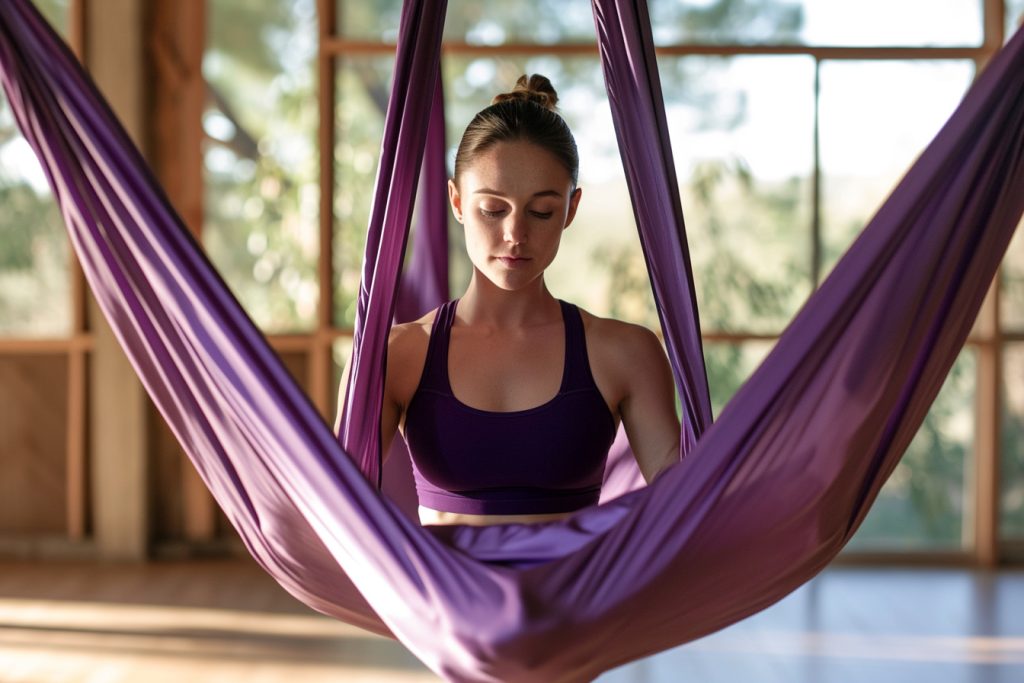When it comes to switching up your yoga routine, taking it off the mat and into the air might just be the exhilarating twist you’re looking for. Aerial yoga, my flying friends, is like the Cirque du Soleil of the yoga world—a fusion of traditional yoga poses, Pilates, and dance with the use of a hammock. It’s a total game-changer for your fitness and flexibility, and it adds a splash of fun and experimentation that ground-based yoga can’t touch. Let’s dive in, or should I say, fly into the world of aerial yoga where you’ll hang tight and fly right into a new dimension of wellness!
Taking Flight: The Basics of Aerial Yoga
Aerial yoga takes your practice into the z-axis, adding a new level of challenge and excitement as you suspend above ground. It’s based on the same principles of mindfulness and physical alignment as traditional yoga but with the added twist of a fabric sling, which supports your body in various postures. The weightlessness achieved in an aerial yoga class can alleviate pressure on the joints, enhance flexibility, and allow for deeper stretches without the same level of exertion or strain experienced on the mat. As you get started, you’ll learn basic grips, wraps, and traps – the foundational maneuvers of aerial yoga that ensure your safety and allow for the fluid transition between poses. Classes typically start with a gentle warm-up on the mat before taking to the silk, slowly elevating your body and your practice.
The beauty of aerial yoga lies in its adaptability for yogis of all levels. Beginners are guided through simple inversions and stretches that utilize the fabric for support, while more experienced practitioners might attempt advanced poses and sequences that require greater strength and control. Aerial yoga can provide a full-body workout, build core strength, and improve balance as you rely on both the hammock and your own body to maintain stability in the air. As with any yoga practice, it’s vital to listen to your body and move at your own pace, ensuring that you keep the flight smooth and enjoyable.
Gear Up: Choosing the Right Equipment
Before you take to the skies, make sure you’ve geared up with the appropriate equipment. The centerpiece of aerial yoga is the aerial hammock or silk—a durable fabric that acts as a swing or trapeze. These are typically made from high-density nylon or polyester with a significant weight capacity to ensure safety. It’s essential to choose a reputable brand and to carefully follow setup instructions. The hammock should be securely attached to beams or bars that are capable of supporting several times your body weight. You’ll also want a comfortable yoga mat for any floor work, as well as tight-fitting clothing that won’t get tangled in the fabric. Loose garments or jewelry can become hazards, so keep it simple and snug.
Additionally, consider the space where your aerial yoga journey will unfold. You need ample room to move, typically with a clear radius of at least a few feet around the hammock and high enough ceilings to hang the apparatus and perform movements without obstructions. Whether you’re setting up at home or joining a class in a studio, the environment should feel safe and inspire confidence. Studios will have the added advantage of professional rigging and a community to support your aerial adventures. Keep in mind, the right equipment is not only a matter of performance but of safety, so invest wisely and prioritize quality.
Hang On: Mastering Aerial Poses
Starting with the fundamentals is the best way to ensure a safe and enjoyable aerial yoga practice. As you advance, you’ll encounter an array of poses that can range from calming and restorative to dynamic and challenging. Poses like the inverted butterfly or aerial pigeon can provide deeper stretches than their earthbound counterparts, thanks to the assistance of the hammock. Building up to these requires practice, as well as a strong focus on core engagement and breath control. It’s common to feel a sense of trepidation when first attempting inversions, but with patience and persistence, the fear will lift, and so will you.
For those with a solid base in traditional yoga, many poses can be translated to their aerial form—think warrior sequence, but in the air! Poses are often introduced in stages, starting in a partially supported position before moving to full suspension. With time, you will learn more complex sequences, linking movements fluidly and floating from one pose to the next. It’s crucial to always pay attention to the guidance of your instructor and to communicate any discomfort or concerns. They’ll help you hang on, adjust your silk, and ensure that your aerial practice helps you soar rather than sore.
Alright, aerobatic yogis, with a grasp on the basics, the right equipment, and a few poses under your belt, you’re well on your way to adding a whole new dimension to your yoga practice. Aerial yoga isn’t just about doing yoga in the air; it’s a novel experience that can redefine your relationship with gravity, your body, and your mind. Remember to hang tight, trust your gear, and give yourself the freedom to fly right into this playful and profound practice. Embrace the float, relish the view from above, and may your aerial yoga journey be as uplifting to your spirit as it is to your body. Happy flying!









